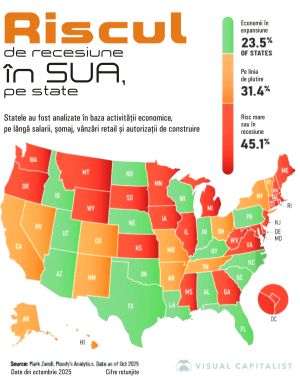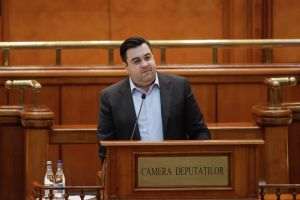Up until after the presidential elections of November 2019, the exchange rate will be kept within a narrow fluctuation band, says economist Lucian Isar. "Young economists in the commercial banks are joking that the only reason the EUR/RON exchange rate hasn't reached 5 lei for an Euro is that since Governor Isărescu didn't know whether he would be elected again, didn't buy Euros out of his 2018 performance bonus.
Wrong.
Up until after the presidential elections of November 2019, the exchange rate will be kept within a narrow fluctuation band, through successive interventions of the NBR, as part of the agreement that the Governor had with Dragnea and now has with Tăriceanu and Dăncilă.
After the presidential elections, just like in the year 2009, and 2015 respectively, the exchange rate will break levels considered as emotionally loaded by the voters. In December 2019/January 2020, that level is 5 lei for one Euro".
In the opinion of Lucian Isar, starting today, as part of the negotiation package, the NBR will no longer be drawing liquidity from the interbank market, thus ceasing the competition it has been for the Ministry of Finance over the last two years. The former Bancpost treasurer told us: "The interest on the government bonds will drop, ROBOR will converge towards the IRCC (ed. note: the replacement of the ROBOR), and the NBR will help through the money spinning circuit set up with commercial banks the funding of the budget deficit, which has already gotten out of control".
In Romania, the current account deficit that has been around for a few years, the drop of the interest rate in lei by allowing liquidity in the market and the decrease in speculative opportunities via carry trade on the EUR/RON pair, the promises of preparing the entry into the Eurozone, suggest the imminence of a correction of the exchange rate, which will take it above 5 lei for an Euro, the economist further told us. In his opinion, without excessive interventions, the exchange rate would not have been kept stable without serious volatility, given the deficits and the incompetence of the current government.
"The threat that the exchange rate would rise by the time his term expired in October played a major part in Isărescu's deal with «the serious people in charge», Tăriceanu and Dăncilă", Lucian Isar further claims.
"Inflation in Romania is no longer a concern for Isărescu, after he found that starting with 2005, since the NBR introduced inflation targeting as a currency policy regime, the median inflation only hit the chosen range in 2012. When Hungary is the only governor where the inflation rate was kept under control, out of all the European countries, the weakening of the leu exchange rate will no longer represent a problem from that point of view either.
The law regulating the NBR has not yet been changed and therefore, the only goal why governor Isărescu should be kept/dismissed, aside from his criminal problems and with the CNSAS, is the failure to meet the inflation target.
Even though the law hasn't been changed, Isărescu is trying to turn the attention of the population towards the joining of the Eurozone, as an objective of the NBR. It is a lot harder to estimate by the Parliament, the preparation of the accession to the Eurozone, whether Isărescu has done his job and he can award himself a performance bonus. The accession to the Eurozone is a strictly political flaw, just like joining the Schengen, regardless of whether you feel you re individually or nominally prepared".
In the opinion of Mr. Isar, the accession to the Eurozone involves the selection of a fluctuation band for the EUR/RON exchange rate, which will be centered on the future exchange rate selected for the conversion: "This conversion rate needs to be a lot higher than the current level, to offset the lack of competitiveness of the Eurozone in the years of belonging to the Eurozone, years when the independence of the monetary and credit policy will be lost.
In conclusion, even though Romania's economy is already asking for a correction of the exchange rate above 5 lei for one Euro, the negotiations and the pressures on the politicians are making it that the NBR will not allow it to be reached, through multiple interventions and the consumption of national resources until after the presidential elections".
NBR governor Mugur Isăres-cu, freshly reelected, said on Thursday that there is a difference between perception and reality and that the perception is that the exchange rate is that it is going towards 5 lei for one Euro, as it tends to drop towards 4.7 lei, "because we have major capital inflows, which could mean that the interest spread is attractive enough, and that situation isn't exactly pleasing for the central bank".
The head of the central bank felt the need to clarify that "the country still has serious people behind the main controls", in response to a question referring to the manner in which he got his new term at the helm of the Central Bank: "Even I can't tell how it happened, if something did happen. I am saying that no special things have happened. You, as the media, you usually catch the less boring, sensational, noisy parts, while the serious talks which nevertheless take place in this country are ... I can assure you, the country still has serious people behind the main controls. The serious talks have probably not reached your ears. And that would be an explanation. You talk about it and it looks to you as if it were something extremely curious. So that is the difference between perception and content. The content has never been as noisy as the perception which you too have seen as dominant".
Mugur Isărescu's current term ends in October, after which he will take on the new five-year term as governor of the NBR.































































1. fără titlu
(message sent by anonim on 09.07.2019, 14:40)
10 lei euro valoare adevarata nebunilor
1.1. :)) (response to opinion no. 1)
(message sent by Vali on 01.08.2019, 22:18)
eh... nici chiar asa mai nene ... o dam dracu din deficit in excedent turbat la 10 ron/1 euro si ingheata toata economia ca frigida in pat cu Van Damme! :)))
2. Euro o ia razna intre Dec 2019 si Ian 2021
(message sent by Vali on 20.07.2019, 12:05)
dupa 8 Noiembrie 2019 intram intr-un ciclu real inflationist cu o durata de 8.6-9.2 ani.
pregatiti-va de impact pe dobanzile platite pentru titlurile de trezorerie.
comentariile cu referire la un nivel nominal pentru un euro sunt hilare.
socul va fi difuzat echilibrat prin canalul dobanzilor si prin canal fx.
pragurile de rezistenta pe eur-ron sunt doar niste .. indicatoare..niste nivele reci. Praguri de rezistenta: eur/ron : 4.785, apoi 4.83, apoi 5.025, apoi tocmai la 5.475.
Peste 5.475 nu mai are rost sa caut praguri de rezistenta pentru ca deja deficitul de cont ar fi fost deja total (mai bine zis: majoritar) stins ... ideal e pragul de 5.025 pentru ajustarea deficitului de cont.
Precum si pentru ajustarea majoritatii psd-alde in Parlament ;) :))))
3. fără titlu
(message sent by Secu on 01.08.2019, 20:21)
CLARVAZATORI = Idioti panicosi
Nu mai bagati lumea in boala. Sa nu uitam cine a facut profit 800-900 de meleoane din schimbul valutar anul trecut?!
3.1. pazea ca vine breeeexiiiiiit (untamed ! ) (response to opinion no. 3)
(message sent by Vali on 01.08.2019, 22:17)
nenea, nenea Secu .. . si cum va face economia UE si zona euro dupa ce iese zgomotos Uk din UE? Cum va face? Va face poc? Si cum vor fi fluxurile financiare din UE si UK ? Vor zbura in SUA? ... Si cum ramane cu exporturile Romaniei ? Sunt ele aproximativ +/- 80% spre UE/zona euro ? Aia care va face poc? Intelegi tu unde bate nenea clarvazatorul ? :)
hai bai nea Secu ca nu mai e mult.... luni de zile.... si imediat si acusica incepe distractia aia mare!
p.s. baga hartii de 100 usd la ciorap si in chilot! :) Sa para mai ...fudulii :))!
4. fără titlu
(message sent by nedelcea on 19.08.2019, 13:47)
cine e Lucian Isar ?